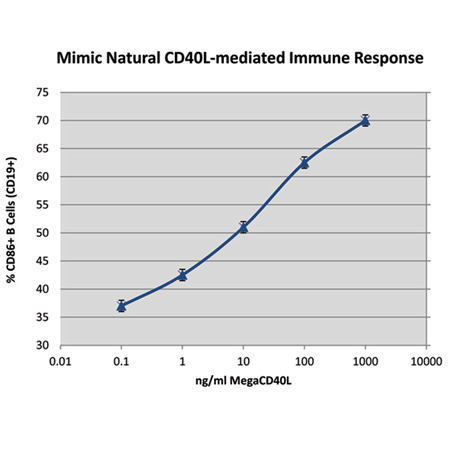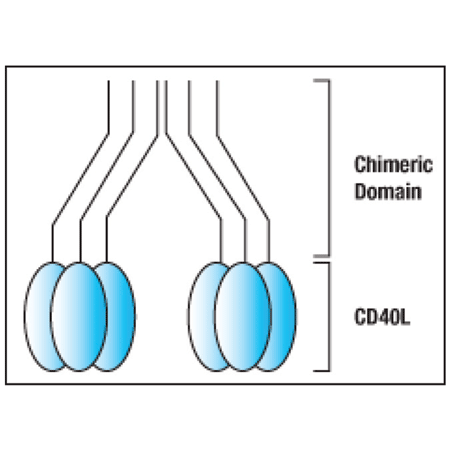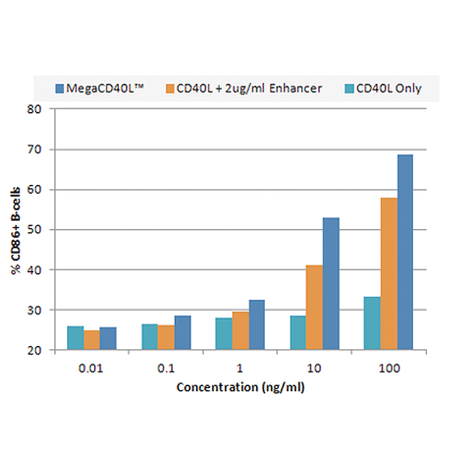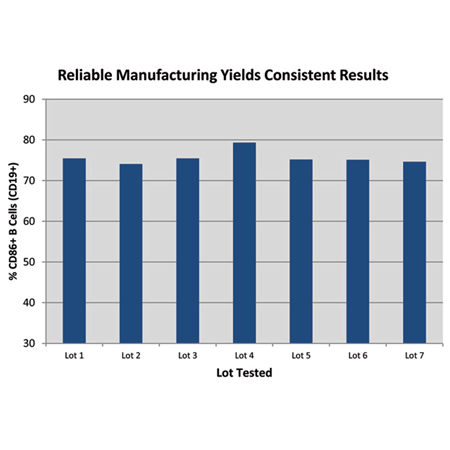| 产品编号 | 产品名称 | 产品规格 | 产品等级 | 产品价格 |
| ALX-522-110-C010 | MEGACD40L (soluble) (human), (recombinant) 重组人Mega CD40L(可溶) |
10 μg |
- 产品特性
- 相关资料
- Q&A
- 参考文献
重组人MEGACD40L® 蛋白(可溶)![]()
用于免疫反应中协同刺激激活的高活性、高纯度CD40L蛋白质
◆特点
● 高活性MEGACD40L® 低聚物模拟体内膜辅助CD40L聚合和激活而无需增强剂
● 高纯度,低内毒素水平
● 丰富的生产经验保证产品批次间一致性和可靠性
● 优化的配方以增强稳定性并提高活性
MEGACD40L是一种高活性蛋白,是两个三聚体CD40配体分子通过Adiponectin/ACRP30/AdipoQ的胶原域人工连接而成。在体内,这种蛋白质能有效的模拟CD40L的天然膜辅助聚合。可简单有效的替代 [CD40L+增强剂]组合(产品编号:ALX-850-064)。
◆产品规格
|
别名 |
CD40L:ACRP30headless, CD154:ACRP30headless, TNFSF 5:ACRP30headless, gp39:ACRP30headless |
|
分子量 |
~38 kDa |
|
来源 |
CHO细胞表达。人CD40L(CD154)(aa 116-261)与小鼠ACRP30headless (aa 18-111)N端以及一个FLAG® -tag融合。 |
|
UniProt ID |
P29965 (human CD40L), Q60994 (mouse Adiponectin) |
|
浓度 |
复溶后0.1 mg/mL |
|
产品类型 |
冻干,含PBS |
|
纯度 |
≥90%(SDS-PAGE) |
|
纯化细节 |
多步层析纯化 |
|
内毒素含量 |
≤0.01EU/μg 纯化蛋白(LAL 测试;Cape Cod Associates) |
|
生物活性 |
与人CD40结合。B细胞激活(已证明存在CD86剂量依赖性上调) |
|
应用 |
可用于调节免疫和炎症反应,作为免疫治疗的临床前研究的一种蛋白质工具, 用来监测病人接受化疗的过程以及模拟自体免疫反应表型。 |
|
配制 |
用100 μL的无菌水溶解。以含5%胎牛血清的培养基进行进一步稀释。 |
|
运输 |
冰袋运输 |
|
长期储存 |
-20℃ |
|
使用/稳定性 |
收货后可稳定储存在-20℃至少6个月 |
|
处理 |
避免反复冻融。复溶后,分装成小份储存于-20℃。 |
|
技术信息/产品说明 |
FLAG是Sigma-Aldrich Co.的注册商标。 |
◆应用实例

MEGACD40L® (产品编号:ALX-522-110)激活B淋巴细胞。方法:外周血单核细胞(PBMCs)37℃、5%CO2 在48孔板(1×106 细胞/孔)中培养48小时。每孔包含200 μL已梯度稀释的MEGACD40L® 无血清测试培养基。处理后,清洗细胞,用小鼠anti-human CD19-PE和小鼠anti-humanCD86-APC进行双重染色,然后用流式细胞术进行分析。所示数据为在不同的MEGACD40L® 浓度下,共染色为CD19+ 和CD86+ B细胞的百分数。

重组人MEGACD40L®(可溶)(产品编号:ALX-522-110)结构示意图

PBMCs(外周血单核细胞)37℃、5%CO2 在48孔板(1×106细胞/孔)中培养48小时,每孔包含200 μL已梯度稀释的MEGACD40L®(产品编号:ALX-522-110)无血清测试培养基、CD40L(产品编号:ALX-522-015)和CD40L+2 μg/mL 增强剂(产品编号:ALX-804-034)。处理后,用PBS+1%BSA清洗细胞3次。用小鼠anti-human CD19(PE偶联)和小鼠anti-humanCD86(APC偶联)进行双重染色,4℃,2小时。用PBS+1%BSA清洗细胞3次,用PBS重悬。样品用BD Facs Calibur 流式细胞分析仪进行分析。所示数据为在不同的浓度下CD86+B细胞百分数/CD19+B细胞百分数。

1000 ng/mL、7个连续批次的MEGACD40L® 用于B细胞激活实验数据

通过在指定的温度下储存蛋白2个月来进行MEGACD40L® 稳定性测试。用B细胞激活实验来进行蛋白活性测试。结果显示在严苛的储存条件下MEGACD40L® 仍能保持较好的活性。
◆相关产品
|
产品编号 |
产品名称 |
包装 |
产品描述 |
|
ALX-522-120-C010 |
MEGACD40L (soluble) (mouse), (recombinant) |
10 μg |
用于免疫反应中协同激活活性的高活性、高纯度CD40L蛋白。 |
|
ALX-850-064-KI01 |
CD40L, soluble (human) (recombinant) set |
1 set |
配体+增强剂用于提高稳定性和增强免疫活性。 |
|
ADI-CSA-187-E |
CD 40L monoclonal antibody (5F3) |
100 μg |
流式细胞术 |
|
ALX-805-037-C100 |
CD40L (human) monoclonal antibody (blocking) (MK13A4) |
100 μg |
流式细胞术,FUNC |
|
ALX-522-015-6010 |
CD40L (soluble) (human), (recombinant) |
6×10 μg |
增加对B细胞的刺激。 |
|
ALX-522-015-2010 |
2×10 μg |
||
|
ALX-522-015-C010 |
10 μg |
参考文献
|
1. |
Artesunate shows potent anti-tumor activity in B-cell lymphoma: T. K. Vatsveen, et al.; J. Hematol. Oncol. 11, 23 (2018) |
|
2. |
CD40L and TNF both activate the classical NF-κB pathway, which is not required for the CD40L induced alternative pathway in endothelial cells: J. Seigner, et al.; Biochem. Biophys. Res. Commun. 495, 1389 (2018) |
|
3. |
CD40L mediated alternative NFκB-signaling induces resistance to BCR-inhibitors in patients with mantle cell lymphoma: H. Rauert-Wunderlich, et al.; Cell Death Dis. 9, 86 (2018) |
|
4. |
Characterisation of anifrolumab, a fully human anti-interferon receptor antagonist antibody for the treatment of systemic lupus erythematosus: J.M. Riggs, et al.; Lupus Sci. Med. 5, (2018) |
|
5. |
Engineering protein-secreting plasma cells by homology-directed repair in primary human B cells: K.L. Hung, et al.; Mol. Ther. 26, 456 (2018) |
|
6. |
High PD-L1/CD86 MFI ratio and IL-10 secretion characterize human regulatory dendritic cells generated for clinical testing in organ transplantation: A.F. Zahorchak, et al.; Cell. Immunol. 323, 9 (2018) |
|
7. |
In vitro antineoplastic effects of auranofin in canine lymphoma cells: H. Zhang, et al.; BMC Cancer 18, 522 (2018) |
|
8. |
CD40 signaling in Graves disease is mediated through canonical and noncanonical thyroidal nuclear factor κB activation: H.J. Lee, et al.; Endocrinology 158, 410 (2017) |
|
9. |
Cutting Edge: Active TGF-β1 Released from GARP/TGF-β1 Complexes on the Surface of Stimulated Human B Lymphocytes Increases Class-Switch Recombination and Production of IgA: O. Dedobbeleer, et al.; J. Immunol. 199, 391 (2017) |
|
10. |
Down‐regulation of CD73 on B cells of patients with viremic HIV correlates with B cell activation and disease progression: E.S. Kim, et al.; J. Leukoc. Biol. 101, 1263 (2017) |
|
11. |
Human secretory IgM emerges from plasma cells clonally related to gut memory B cells and targets highly diverse commensals: G. Magri, et al.; Immunity 47, 118 (2017) |
|
12. |
Regulation of cell surface CB2 receptor during Human B cell activation and differentiation: J.T. Castaneda, et al.; J. Neuroimmune Pharmacol. 12, 544 (2017) |
|
13. |
CD40 expression in fibrocytes Is induced by TSH: potential synergistic immune activation: T. Mester, et al.; PLoS One 11, e0162994 (2016) |
|
14. |
Distinct TLR-mediated cytokine production and immunoglobulin secretion in human newborn naïve B cells: M.A. Pettengill, et al.; Innate Immun. 22, 433 (2016) |
|
15. |
Expression of HIV-1 matrix protein p17 and association with B-cell lymphoma in HIV-1 transgenic mice: V.A. Carroll, et al.; PNAS 113, 13168 (2016), Application(s): Human B cells culture |
|
16. |
T-helper signals restore B-cell receptor signaling in autoreactive anergic B cells by upregulating CD45 phosphatase activity: P. Szodoray, et al.; J. Allergy Clin. Immunol. 138, 839 (2016), Application(s): Cell culture |
|
17. |
A human monoclonal antibody targeting the conserved staphylococcal antigen IsaA protects mice against Staphylococcus aureus bacteremia: S. van den Berg, et al.; Int. J. Med. Microbiol. 305, 55 (2015), Application(s): ELISA, PCR of human blood samples |
|
18. |
CD40L Induces Functional Tunneling Nanotube Networks Exclusively in Dendritic Cells Programmed by Mediators of Type 1 Immunity: C. Zaccard, et al.; J. Immunol. 194, 1047 (2015), Application(s): Activation of mature human dendritic cells |
|
19. |
Detection of IκB degradation dynamics and IκB-α ubiquitination: P. Starokadomskyy, et al.; Methods Mol. Biol. 1280, 15 (2015) |
|
20. |
Establishing the pig as a large animal model for vaccine development against human cancer: N.H. Overgaard, et al.; Front. Genet. 6, 286 (2015), Abstract; Full Text |
|
21. |
Haploinsufficiency of the NF-κB1 subunit p50 in common variable immunodeficiency: M. Fliegauf, et al.; Am. J. Hum. Genet. 97, 389 (2015) |
|
22. |
Mechanism and functional impact of CD40 ligand-induced von Willebrand factor release from endothelial cells: K. Möller, et al.; Thromb. Haemost. 113, 1095 (2015) |
|
23. |
NF-κB, p38 MAPK, ERK1/2, mTOR, STAT3 and increased glycolysis regulate stability of paricalcitol/dexamethasone-generated tolerogenic dendritic cells in the inflammatory environment: K. Danova, et al.; Oncotarget 6, 14123 (2015) |
|
24. |
Phenotypic Approaches to Identify Inhibitors of B Cell Activation: E. B. Rex, et al.; J. Biomol. Screen. 20, 876 (2015), Application(s): Assay |
|
25. |
Systemic agonistic anti-CD40 treatment of tumor-bearing mice modulates hepatic myeloid-suppressive cells and causes immune-mediated liver damage: J. Medina-Echeverz, et al.; Cancer Immunol. Res. 3, 557 (2015) |
|
26. |
A GPBAR1 (TGR5) small molecule agonist shows specific inhibitory effects on myeloid cell activation in vitro and reduces experimental autoimmune encephalitis (EAE) in vivo: N. Lewis, et al.; PLoS One 9, e100883 (2014), Application(s): Assay of human PBMC |
|
27. |
Development of a novel anti-canine CD20 monoclonal antibody with diagnostic and therapeutic potential: D. Ito, et al.; Leuk. Lymphoma 56, 219 (2014), Application(s): Analysis of canine B-cell lymphoma cells |
|
28. |
Exosomes Derived from Burkitt’s Lymphoma Cell Lines Induce Proliferation, Differentiation, and Class-Switch Recombination in B Cells: C. Gutzeit, et al.; J. Immunol. 192, 5852 (2014), Application(s): PCR, Assay of human B cells |
|
29. |
Preclinical evaluation of the novel, orally bioavailable Selective Inhibitor of Nuclear Export (SINE) KPT-335 in spontaneous canine cancer: results of a phase I study: C. London, et al.; PLoS One 9, e87585 (2014), Application(s): Analysis of canine tumor cells by WB, FLOW |
|
30. |
Thyrotropin receptor and CD40 mediate interleukin-8 expression in fibrocytes: implications for thyroid-associated ophthalmopathy (an American Ophthalmological Society thesis).: R. Douglas, et al.; Trans. Am. Ophthalmol. Soc. 12, 26 (2014), Application(s): In vitro analysis of human fibrocytes |
|
31. |
AMPKα1 deficiency amplifies proinflammatory myeloid APC activity and CD40 signaling: K.C. Carroll, et al.; J. Leukoc. Biol. 94, 1113 (2013) |
|
32. |
Blood CD4+CD45RO+CXCR5+ T cells are decreased but partially functional in signal transducer and activator of transcription 3 deficiency: F. Mazerolles, et al.; J. Allergy Clin. Immunol. 131, 1146 (2013), Application(s): Assay of blood cells |
|
33. |
CD40 ligand is necessary and suffi cient to support primary diff use large B-cell lymphoma cells in culture: a tool for in vitro preclinical studies with primary B-cell malignancies: D. Ito, et al.; Leuk. Lymphoma 53, 1390 (2012), Application(s): Flow cytometry of human B cells |
|
34. |
HIV-1 gp120 impairs the induction of B cell responses by TLR9-activated plasmacytoid dendritic cells: N.P. Chung, et al.; J. Immunol. 189, 5257 (2012), Application(s): Activation of dendritic cells |
|
35. |
Immunodeficiency, autoinflammation and amylopectinosis in humans with inherited HOIL-1 and LUBAC deficiency: B. Boisson, et al.; Nat. Immunol. 13, 1178 (2012), Application(s): ELISA of human blood cells |
|
36. |
Interleukin-6 Production in CD40-Engaged Fibrocytes in Thyroid-Associated Ophthalmopathy: Involvement of Akt and NF-κB: E.F. Gillespie, et al.; Invest. Ophthalmol. Vis. Sci. 53, 7746 (2012), Application(s): CD40 ligation, induction and signaling in Graves' orbital fibroblasts (GOFB) and fibrocytes |
|
37. |
Siglec-7 tetramers characterize B-cell subpopulations and leukemic blasts: F. Gieseke, et al.; Eur. J. Immunol. 42, 2176 (2012), Application(s): ELISA of human B cells |
|
38. |
New mechanism of X-linked anhidrotic ectodermal dysplasia with immunodeficiency: impairment of ubiquitin binding despite normal folding of NEMO protein: M. Hubeau, et al.; Blood 118, 926 (2011) |
|
39. |
Reconstitution of huPBL-NSG mice with donor-matched dendritic cells enables antigen-specific T-cell activation: A. Harui, et al.; J. Neuroimmune Pharmacol. 6, 148 (2011), Application(s): Activation of dendritic cells |
|
40. |
Study of patients with Hyper-IgM type IV phenotype who recovered spontaneously during late childhood and review of the literature: N. Karaca, et al.; Eur. J. Pediatr. 170, 1039 (2011), Application(s): Determining human B-cell function in Hyper-IgM blood samples |
|
41. |
Human TRAF3 adaptor molecule deficiency leads to impaired Toll-like Receptor 3 response and susceptibility to Herpes Simplex Encephalitis: R. Perez de Diego, et al.; Immunity 33, 400 (2010) |
|
42. |
Multimeric soluble CD40 ligand (sCD40L) efficiently enhances HIV specific cellular immune responses during DNA prime and boost with attenuated poxvirus ventors MVA and NYVAC expressing HIV antigens : C.E. Gomez, et al.; Vaccine 27, 3165 (2009) |
|
43. |
Impaired CD40L signaling is a cause of defective IL-12 and TNF-alpha production in Sezary syndrome: circumvention by hexameric soluble CD40L: L.E. French, et al.; Blood 105, 219 (2005) |
|
44. |
Two adjacent trimeric Fas ligands are required for Fas signaling and formation of a death-inducing signaling complex: N. Holler, et al.; Mol. Cell. Biol. 23, 1428 (2003) |
